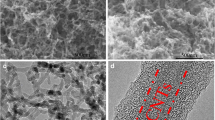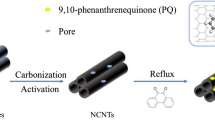Abstract
Nitrogen and phosphorous dual-doped carbon nanotubes (N,P/CNT) have been grown in a single-step direct synthesis process by CVD method using iron-loaded mesoporous SBA-15 support, as an electrode material for the energy storage device. For comparison, pristine nanotubes, nitrogen and phosphorous individually doped nanotubes were also prepared. The basic characterization studies clarify the formation of nanotubes and the elemental mapping tells about the presence of the dopant. Under three-electrode investigations, N,P/CNT produced a maximum specific capacitance of about 358.2 F/g at 0.5 A/g current density. The electrochemical performance of N,P/CNT was further extended by fabricating as a symmetric supercapacitor device, which delivers 108.6 F/g of specific capacitance for 0.5 A/g with 15 Wh/kg energy density and 250 W/kg power density. The observed energy efficiency of the device was 92.3%. The capacitance retention and coulombic efficiency were 96.2% and 90.6%, respectively, calculated over 5000 charge–discharge cycles.
Graphical abstract









Similar content being viewed by others
Data availability
All relevant data are available from the authors upon reasonable request.
References
Anzar N, Hasan R, Tyagi M, Yadav N, Narang J (2020) Carbon nanotube—a review on synthesis, properties and plethora of applications in the field of biomedical science. Sensors Int 1:100003. https://doi.org/10.1016/j.sintl.2020.100003
Candelaria SL, Shao Y, Zhou W, Li X, Xiao J, Zhang J, Wang Y, Liu J, Li J, Cao G (2012) Nanostructured carbon for energy storage and conversion. Nano Energy 1:195–220. https://doi.org/10.1016/j.nanoen.2011.11.006
Allen BL, Kichambare PD, Star A (2008) Synthesis, charcterization and manipulation of nitrogen-doped carbon nanotube cups. ACS Nano 2:1914–1920
Chizari K, Vena A, Laurentius L, Sundararaj U (2013) The effect of temperature on the morphology and chemical surface properties of nitrogen-doped carbon nanotubes. Carbon 68:369–379. https://doi.org/10.1016/j.carbon.2013.11.013
Kokarneswaran M, Selvaraj P, Ashokan T, Perumal S (2020) Discovery of carbon nanotubes in sixth century BC potteries from Keeladi, India. Sci Rep 10:1–6. https://doi.org/10.1038/s41598-020-76720-z
Iqbal S, Khatoon H, Pandit AH, Ahmad S (2019) Recent development of carbon based materials for energy storage devices. Mater Sci Energy Technol 2:417–428. https://doi.org/10.1016/j.mset.2019.04.006
Larrude DG, Costa MEHM, Monteiro FH, Pinto AL, Freire FL (2012) Characterization of phosphorus-doped multiwalled carbon nanotubes. J Appl Phys 111:064315. https://doi.org/10.1063/1.3695452
Zhang ZJ, Zheng QC, Sun L, Xu D, Chen XY (2017) Two-dimensional carbon nanosheets for high-performance supercapacitors: large-scale synthesis and codoping with nitrogen and phosphorus. Ind Eng Chem Res 56:12344–12353. https://doi.org/10.1021/acs.iecr.7b03022
Cruz-silva E, Cullen DA, Gu L, Romo-herrera JM, Munoz-sandoval E, Lopezurias F, Sumpter BG, Meunier V, Charlier J, Smith DJ, Terrones H, Terrones M (2008) Heterodoped nanotubes: theory, synthesis, characteisation of phosphorous–nitrogen doped multiwalled carbon nanotubes. ACS Nano 2:441–448
Vinodh R, Babu RS, Gopi CVVM, Deviprasath C, Atchudan R, Samyn LM, Barros ALF, Kim HJYM (2020) Influence of annealing temperatutre in nitrogen doped porous carbon balls derived from hypercross-linked polymer of anthracene for supercapacitor applications. J Energy Storage 28:101196
Cruz-silva E, Lopez-urias F, Munoz-sandoval E, Sumpter BG, Terrones H, Charlier J, Terrones M (2011) Phosphorus and phosphorus–nitrogen doped carbon nanotubes for ultrasensitive and selective molecular detection. Nanoscale 3:1008–1013. https://doi.org/10.1039/c0nr00519c
Huang C, Puziy AM, Poddubnaya OI, Hulicova-jurcakova D, Sobiesiak M, Gawdzik B (2018) Phosphorus, nitrogen and oxygen co-doped polymer-based core-shell carbon sphere for high-performance hybrid supercapacitors. Electrochim Acta 270:339–351. https://doi.org/10.1016/j.electacta.2018.02.115
Balamurugan J, Pandurangan A, Thangamuthu R, Senthilkumar SM (2013) Effective synthesis of well-graphitized carbon nanotubes on bimetallic SBA-15 template for use as counter electrode in dye-sensitized solar cells. Ind Eng Chem Res 52:384–393
Ortega-Cervantez C, Rueda-Morales G, Ortiz-Lopez J (2005) Catalytic CVD production of carbon nanotubes using ethanol. Microelectronics J 36:495–498. https://doi.org/10.1016/j.mejo.2005.02.062
Somanathan T, Pandurangan A (2010) Helical multiwalled carbon nanotubes (h-MWCNTs) synthesized by catalytic chemical vapor deposition. New Carbon Mater 25:175–180. https://doi.org/10.1016/S1872-5805(09)60024-X
Dundar-tekkaya E, Karatepe N (2011) Production of carbon nanotubes by iron catalyst. Int J Mater Metall Eng 5:541–547
Hoyos-Palacio L, Garcia A, Perez-Robles J, Gonzalez J, Martinez-Tejada HV (2014) Catalytic effect of Fe, Ni, Co and Mo on the CNTs production. IOP Conf Ser Mater Sci Eng 59:012005
Ragavan R, Pandurangan A (2017) Facile synthesis and supercapacitor performances of nitrogen doped CNTs grown over mesoporous Fe/SBA-15 catalyst. New J Chem 41:11591–11599. https://doi.org/10.1039/c7nj00804j
Wang Z, Jia R, Zheng J, Zhao J, Li L, Song J, Zhu Z (2011) Nitrogen-promoted self-assembly of n-doped carbon nanotubes and their intrinsic catalysis for oxygen reduction in fuel cells. ACS Nano 5:1677–1684
Poonam SK, Arora A, Tripathi SK (2019) Review of supercapacitors: materials and devices. J Energy Storage 21:801–825. https://doi.org/10.1016/j.est.2019.01.010
Wu G, Tan P, Wang D, Li Z, Peng L, Hu Y, Wang C, Zhu W, Chen S, Chen W (2017) High-performance supercapacitors based on electrochemical-induced vertical-aligned carbon nanotubes and polyaniline nanocomposite electrodes. Sci Rep 7:1–8. https://doi.org/10.1038/srep43676
Frackowiak E, Abbas Q (2013) Carbon/carbon supercapacitors. J Energy Chem 22:226–240. https://doi.org/10.1016/S2095-4956(13)60028-5
Liu C, Liu Y, Yi T, Hu C (2019) Carbon materials for high-voltage supercapacitors. Carbon 145:529–548. https://doi.org/10.1016/j.carbon.2018.12.009
Rangom Y, Tang XS, Nazar LF (2015) Carbon nanotube-based supercapacitors with excellent ac line filtering and rate capability via improved interfacial impedance. ACS Nano 9:7248–7255
Pan H, Li J, Ping Y (2010) Carbon nanotubes for supercapacitor. Nanoscale Res Lett 5:654–668. https://doi.org/10.1007/s11671-009-9508-2
Gonzalez A, Goikolea E, Andoni J, Mysyk R (2016) Review on supercapacitors: technologies and materials. Renew Sustain Energy Rev 58:1189–1206. https://doi.org/10.1016/j.rser.2015.12.249
Wang G, Zhang L, Zhang J (2012) A review of electrode materials for electrochemical supercapacitors. Chem Soc Rev 41:797–828. https://doi.org/10.1039/c1cs15060j
Zhong C, Deng Y, Hu W, Qiao J, Zhang L, Zhang J (2015) A review of electrolyte materials and compositions for electrochemical supercapacitors. Chem Soc Rev 44:7484–7539. https://doi.org/10.1039/c5cs00303b
Pal B, Yang S, Ramesh S, Thangadurai V, Jose R (2019) Electrolyte selection for supercapacitive devices: a critical review. Nanoscale Adv 1:3807–3835. https://doi.org/10.1039/c9na00374f
Zhao D, Feng J, Huo Q, Melosh N, Fredrickson G, Chmelka B, Stucky G (1998) Triblock copolymer syntheses of mesoporous silica with periodic 50 to 300 angstrom pores. Science 279:548–552
Atchudan R, Pandurangan A, Somanathan T (2009) Bimetallic mesoporous materials for high yield synthesis of carbon nanotubes by chemical vapour deposition techniques. J Mol Catal A Chem 309:146–152. https://doi.org/10.1016/j.molcata.2009.05.010
Johnsirani D, Pandurangan A (2020) Chromium, fluorine and nitrogen tri-doped graphene sheets as an active electrode material for symmetric supercapacitors. Diam Relat Mater 105:107800. https://doi.org/10.1016/j.diamond.2020.107800
Huang H, Ji Y, Qiao Z, Zhao C, He JZH (2010) Preparation, characterization, and application of magnetic Fe-SBA-15 mesoporous silica molecular sieves. J Autom Methods Manag Chem 2010:1–7
Wang C, Zhou Y, Sun L, Wan P, Zhang X, Qiu J (2013) Sustainable synthesis of phosphorus- and nitrogen-co-doped porous carbons with tunable surface properties for supercapacitors. J Power Sources 239:81–88. https://doi.org/10.1016/j.jpowsour.2013.03.126
Zhou J, Ye S, Zeng Q, Yang H, Chen J, Guo Z, Jiang H, Rajan K (2020) Nitrogen and phosphorus co-doped porous carbon for for high-performance supercapacitors. Front Chem 8:1–8. https://doi.org/10.3389/fchem.2020.00105
Kishore C, Pandurangan A (2014) Facile synthesis of carbon nanotubes and their use in the fabrication of resistive switching memory device. RSC Adv 4:9905–9911. https://doi.org/10.1039/c3ra45359f
Zafar Z, Ni ZH, Wu X, Shi ZX, Nan HY, Bai J, Sun LT (2013) Evolution of Raman spectra in nitrogen doped graphene. Carbon 61:57–62. https://doi.org/10.1016/j.carbon.2013.04.065
Jin J, Qiao X, Zhou F, Wu Z, Cui L, Fan H (2017) Interconnected phosphorus and nitrogen codoped porous exfoliated carbon nanosheets for high-rate supercapacitors. ACS Appl Mater Interfaces 9:17317–17325. https://doi.org/10.1021/acsami.7b00617
Daems N, Sheng X, Vankelecom IFJ, Pescarmona PP (2015) Metal-free doped carbon materials as electrocatalysts for the oxygen reduction reaction. J Mater Chem A 2:4085. https://doi.org/10.1039/C3TA14043A
Yao Y, Zhang B, Shi J, Yang Q (2015) Preparation of nitrogen-doped carbon nanotubes with different morphologies from melamine-formaldehyde resin. ACS Appl Mater Interfaces 7:7413–7420. https://doi.org/10.1021/acsami.5b01233
Li X, Lv Z, Wu M, Li X, Li Z (2021) N, P co-doped porous carbon from cross-linking cyclophosphazene for high-performance supercapacitors. J Electroanal Chem 881:114952. https://doi.org/10.1016/j.jelechem.2020.114952
Qiao X, Liao S, You C, Chen R (2015) Phosphorus and nitrogen dual doped and simultaneously reduced graphene oxide with high surface area as efficient metal-free electrocatalyst for oxygen reduction. Catalysts 5:981–991. https://doi.org/10.3390/catal5020981
Laschuk NO, Easton EB, Zenkina OV (2021) Reducing the resistance for the use of electrochemical impedance spectroscopy analysis in materials chemistry. RSC Adv 11:27925–27936. https://doi.org/10.1039/d1ra03785d
Basnayaka PA, Ram MK, Stefanakos L, Kumar A (2013) Graphene/polypyrrole nanocomposite as electrochemical supercapacitor electrode: electrochemical impedance studies. Graphene 2:81–87. https://doi.org/10.4236/graphene.2013.22012
Lazanas AC, Prodromidis MI (2023) Electrochemical impedance spectroscopy—a tutorial. ACS Meas Sci Au. https://doi.org/10.1021/acsmeasuresciau.2c00070
Eftekhari A (2017) Energy efficiency: a critically important but neglected factor in battery research. Sustain Energy Fuels 1:2053–2060. https://doi.org/10.1039/c7se00350a
Xia K, Huang Z, Zheng L, Han B, Gao Q, Zhou C, Wang H, Wu J (2017) Facile and controllable synthesis of N/P co-doped graphene for high-performance supercapacitors. J Power Sources 365:380–388. https://doi.org/10.1016/j.jpowsour.2017.09.008
Li Z, Wang Y, Xia W, Gong J, Jia S, Zhang J (2020) Nitrogen, phosphorus and sulfur co-doped pyrolyzed bacterial cellulose nanofibers for supercapacitors. Nanomaterials 10:1–13. https://doi.org/10.3390/nano10101912
Chen B, Wu W, Li C, Wang Y, Zhang Y, Fu L, Zhu Y, Zhang L, Wu Y (2019) Oxygen/phosphorus co-doped porous carbon from cicada slough as high-performance electrode material for supercapacitors. Sci Rep 9:1–8. https://doi.org/10.1038/s41598-019-41769-y
Thirumal V, Pandurangan A, Jayavel R, Krishnamoorthi SR, Ilangovan R (2016) Synthesis of nitrogen doped coiled double walled carbon nanotubes by chemical vapor deposition method for supercapacitor applications. Curr Appl Phys 16:816–825. https://doi.org/10.1016/j.cap.2016.04.018
Nasini UB, Gopal V, Ramashagayam SK, Bourdo SE, Viswanathan T, Shaikh AU (2014) Phosphorous and nitrogen dual heteroatom doped mesoporous carbon synthesized via microwave method for supercapacitor application. J Power Sources 250:257–265. https://doi.org/10.1016/j.jpowsour.2013.11.014
Acknowledgements
One of the authors, D. Johnsirani acknowledges the Anna Centenary Research Fellowship (ACRF) funded by Anna University, Chennai for the financial support to carry out this work. The authors are thankful to the DST-FIST-sponsored Department of Chemistry, Anna University for providing the laboratory and instrumentation facilities.
Author information
Authors and Affiliations
Corresponding author
Ethics declarations
Conflict of interest
This work has no conflict of interest to declare.
Additional information
Publisher's Note
Springer Nature remains neutral with regard to jurisdictional claims in published maps and institutional affiliations.
Supplementary Information
Below is the link to the electronic supplementary material.
Rights and permissions
Springer Nature or its licensor (e.g. a society or other partner) holds exclusive rights to this article under a publishing agreement with the author(s) or other rightsholder(s); author self-archiving of the accepted manuscript version of this article is solely governed by the terms of such publishing agreement and applicable law.
About this article
Cite this article
Devarajan, J., Arumugam, P. Nitrogen and phosphorous co-doped carbon nanotubes for high-performance supercapacitors. Carbon Lett. 33, 1615–1627 (2023). https://doi.org/10.1007/s42823-023-00532-0
Received:
Revised:
Accepted:
Published:
Issue Date:
DOI: https://doi.org/10.1007/s42823-023-00532-0




